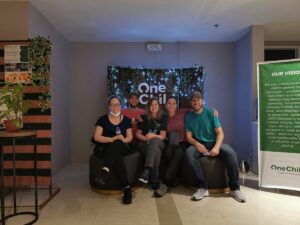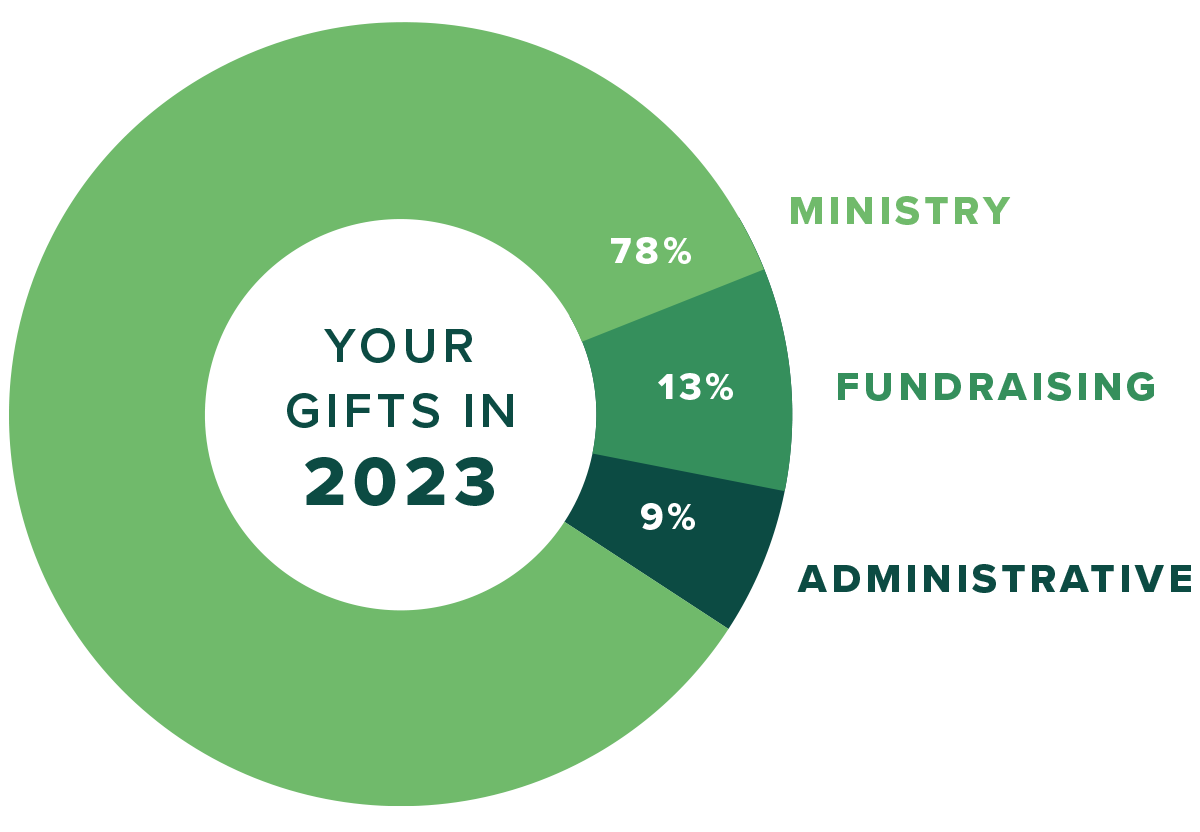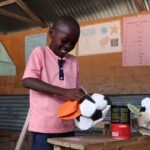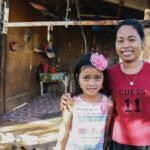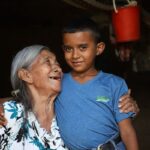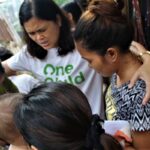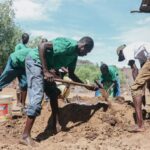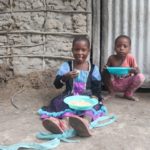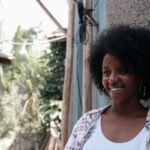Going from being the world’s biggest homebody to taking four planes to the other side of the world was a shock to the system — and just the jolt I needed!
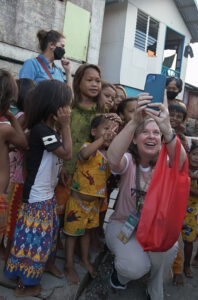
OneChild staff member Danette Kertz takes a selfie with some of the Badjao kids.
Let’s get one thing straight — I don’t travel.
Other than a three-week trip to England 20 years ago, my body has remained in its comfort zone. I am terrified of flying (especially over water), I don’t sleep well as a rule and not at all in a strange place, and I couldn’t imagine doing without my age-appropriate creature comforts.
I don’t have an adventurous or spontaneous bone in my body.
So, for the last seven years of working for OneChild, I’ve stayed close to home, sending my heart out to wander the hard places while the rest of me was safe and sound in a familiar environment.
And when that heart came back each time a bit more bruised and battered than before, I was certain that the entirety of me could never handle such a journey.
I was convinced that my eyes would be so filled with tears the whole time I’d miss everything there was to see as I lost myself to all there was to feel.
I couldn’t have been more wrong.
When I was first invited to attend our Asia Regional Conference, held in Davao City in the Philippines, my initial, knee-jerk reaction was to show adequate gratitude for the honor of being asked and politely (yet swiftly) decline.
Even though, for the first time in years, beloved colleagues from all the Asian countries where we work would be there for a conference to share experiences, attend training workshops which I would help lead, create efficiencies, encourage one another, and pray together, I was still skeptical.
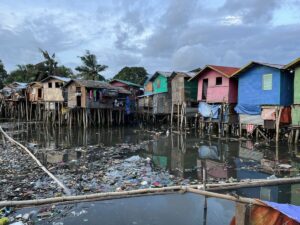
The Badjao people live in one-room shelters made of tin and wood on stilts at the water’s edge.
But something stopped me from hitting SEND on that response email, and instead, I asked my husband what he thought. His immediate affirmation that it would be tragic to miss this opportunity gave me the push I needed to accept and start making plans.
And those plans included buying travel gear. Lots of travel gear. Amazon absolutely loves me now.
With the help of some well-traveled guides, I survived four different flights and running with a 20-lb backpack through the San Francisco airport (which bruised my back and my ego) to narrowly make our next leg to South Korea.
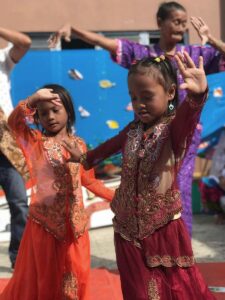
A welcome ceremony included children dressed in traditional garb dancing.
A Joyous Welcome
After multiple delays, we arrived at our hotel in the Philippines, bone-dead tired and in dire need of a wardrobe change and swish of mouthwash.
But our gracious hosts greeted us ready to commemorate our arrival with photos and a delicious meal that we simply could not postpone, so I had my first taste of a popular Filipino dish: fried chicken. My Texan roots were overjoyed, and the exhaustion from travel was replaced by good food and even better conversation.
As I planned and overthought how things would go (none of which was at all accurate btw), I assumed that we would do all of the “conference-y” things first — all the meetings and sessions and trainings and whatnot — and do our visits to the Hope Centers at the end of the week. Wrong again. (At this point, it was becoming clear that me having no clue about anything was the theme of this trip.)
The Regional Program Support Manager, “Kuya” Toyditz Cosico, knew better. Along with his wife, Country Director “Ate” Manette Cosico, they strategically planned things so that we guests had the opportunity to see firsthand OneChild’s Hope Centers, the Child Champions working and volunteering there, and of course all the adorable children being served — at the beginning rather than the end, for the express purpose of putting those images in our minds as we went through our conference sessions.
It was brilliant. Because once you see and smell and touch the hard places, you can’t think of much else. And this made all of those discussions and presentations take on a new life — because we could SEE how these clerical things impacted real actual LIVES.
The Plight of the Badjao
Our team in the Philippines did me such a solid by assigning me to visit the Matina Aplaya where a dear friend and coworker of mine sponsors two sisters.

Danette walks with Justin (in green shirt) and Jumina through the Badjao community.
The Badjao community is a dangerous place to live. As a sea nomadic tribe, they are unwelcome on the land where they were forced to settle because of over-fishing, once their primary source of sustenance and income. They do not speak the local language. The children don’t have birth certificates or go to school.
Often misunderstood and judged, the Badjao aren’t even recognized as Filipino citizens.
But they embrace their cultural identity and traditions, they practice bayanihan — mutual cooperation for the public good — and they love their children fiercely.
There was music and dancing and waving and laughter when we arrived. A welcome celebration was in full swing, with music, bright, traditional garb, and well-practiced moves by children and adults alike. Introductions were made (I’m pretty sure I said something stupid yet heartfelt in mine that I hope the translator cleaned up for me) and handmade cloth leis with tinkling bells placed around our necks.
And our Philippine team took the blessing further by setting up a home visit with my friend’s girls so that I could present them with gifts from her (and a few trinkets from me) and meet their family. It was one of the best surprises of my life.
Unprepared for Walk Through Sludge
But I was in no way prepared for the walk from the one-room, cinderblock Hope Center to the one-room bamboo-and-tin shelter on stilts those kids call home.
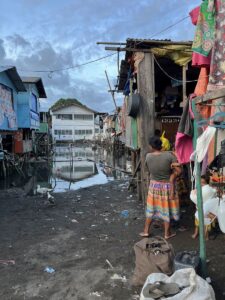
Badjao community residents regularly walk barefoot through sludge and polluted water.
Even though we were there during low tide, we had to walk over half-buried concrete culverts and slick stones, squeeze through narrow, garbage-littered alleyways, and hop over (unsuccessfully) puddles of sludgy fish and fecal soup.
The smell is something I will never forget. The feeling of that muddy water seeping through my brand-new travel socks and shoes will be with me forever. The fact that neither of those things bothered me in the least that moment was the realization of a lifetime.
We climbed up rickety rungs and across a narrow, unstable little bridge to get to the entrance of the house.
My companions and I started to kick off our slip-on shoes to avoid tracking mud inside, but our guide, Pastor John, along with the father of the family we were visiting wouldn’t hear of it.
So, we gingerly made our way inside, cringing at how we were surely soiling the immaculate bamboo strips that made up the floor and sat on that floor in a ring around the single small room that the family of eight occupied.
The only “seat” in the house was a ledge beneath a window opening which was just long and wide enough for a thin, frail grandmother to rest upon.
I was sure everyone else slept on the floor where we were sitting with barely enough space to fit even with our legs tucked up under us.
There were few possessions in that room. A sparse smattering of dishes and just washed clothes draped over railings to dry. Some bags holding used shoes that the family would clean and resell. No toys. And no shoes for most of the children either.
The kids here have no choice but to walk through garbage and raw sewage to get anywhere in the community, which leaves them vulnerable to skin and respiratory infections and at risk of dying of preventable diseases.
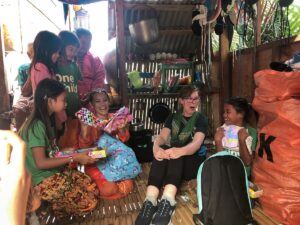
Danette visits her friend Sarah’s sponsored girls at home in the Badjao community in the Philppines: Patricia in orange with head-dress, and Mikay right, in the green shirt. She brought gifts from their sponsor and met their families.
We asked the girls if they received letters from their sponsors, and they had. But those beloved messages had been lost in the latest typhoon that had destroyed their home and everything they owned.
It seemed the Badjao “traveled light” for a reason. The less you have, the less you have to lose.
Gifts Help Break the Ice
The visit was awkward in that the language barrier kept us from really connecting. But once the girls began unpacking their gifts (with two of their siblings and two cousins watching every move), the mood lightened, shoulders relaxed, and all the adults smiled and laughed at the delighted squeals as the kids discovered treasure after treasure hidden in their stylish new backpacks.
Hard candies were immediately opened and shared with the other children without hesitation. New shorts and sundresses and tank-tops were all put on at once. Brown-skinned Barbie dolls were clutched to tiny chests with glee. It was the best sight in the world.
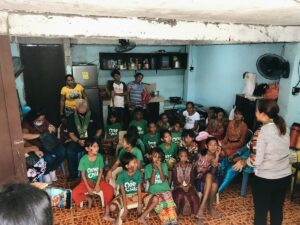
Kids at the Matina Aplaya Hope Center in the Badjao community in the Philippines.
When it was time to leave, I hugged their mother and thanked her for loving her children so well — for getting them enrolled at the Hope Center so that they could have the things they deserved (like a regular meal, medical attention, an education). I doubt even with translation she understood all that I said. But as I pulled back with tears in my eyes and saw tears in her eyes, I knew she could feel it.
We left just as the sun set, and I sat in the back of the van so that I could wave goodbye to the children trailing behind in the red glow of our taillights.
Bemoaning the Injustices
It’s not fair that I got to leave and go back to a nice hotel and take a hot shower and eat whatever I wanted, and they had to stay behind. It’s not fair that at the same time I was washing stinking sludge off my shoes in the bathtub, they were walking through it in bare feet to get home. It’s not fair that I crawled into a comfortable bed that I hadn’t had to make while they slept on a crowded floor.
Asia Regional Conference attendees OneChild staff members (left to right) Leanna Summers, Crawford Brooks, Danette Kertz, Teresa Schauer, and Peter Bratt
But that’s why I do the work I do. So they can have the choice to go out into the world someday. So they can have an education and health care and opportunities for a better life. So they can have HOPE.
There are 60 children enrolled at Matina Aplaya Hope Center, a fraction of all the kids who need help there. And their one-room Hope Center can only hold half at a time, so they aren’t able to attend as a whole group.
We were told how much an expansion — consisting of only walls, a floor, and a roof — would cost. It’s not even close to being an insurmountable sum in USD. Not to my coworkers and me. Not to many Americans.
Together, I know we can make this happen for these kids and so many others like them all over the world who need a safe, clean place to grow, learn, and thrive. I’ll be going on more trips (I’ve got the travel bug BAD), and that means I’ll be seeing more hard places firsthand. And I’ll advocate for them too. Because every child deserves a chance.
If you’d like to help, please consider making a donation to OneChild’s Partner’s Fund, an unrestricted fund that helps us reach more kids and bring them hope.
See some powerful images and insights a group of photographers and videographers gathered from a trip to the Philippines with OneChild.
We are accountable to the children we serve AND to our donors.
Our accountability to our donors is one of our highest priorities. Our goal is to use the funds entrusted to us as wise stewards. To do this requires continued monitoring of our fund distribution. OneChild is also a member in good standing with the Evangelical Council for Financial Accountability (ECFA)
